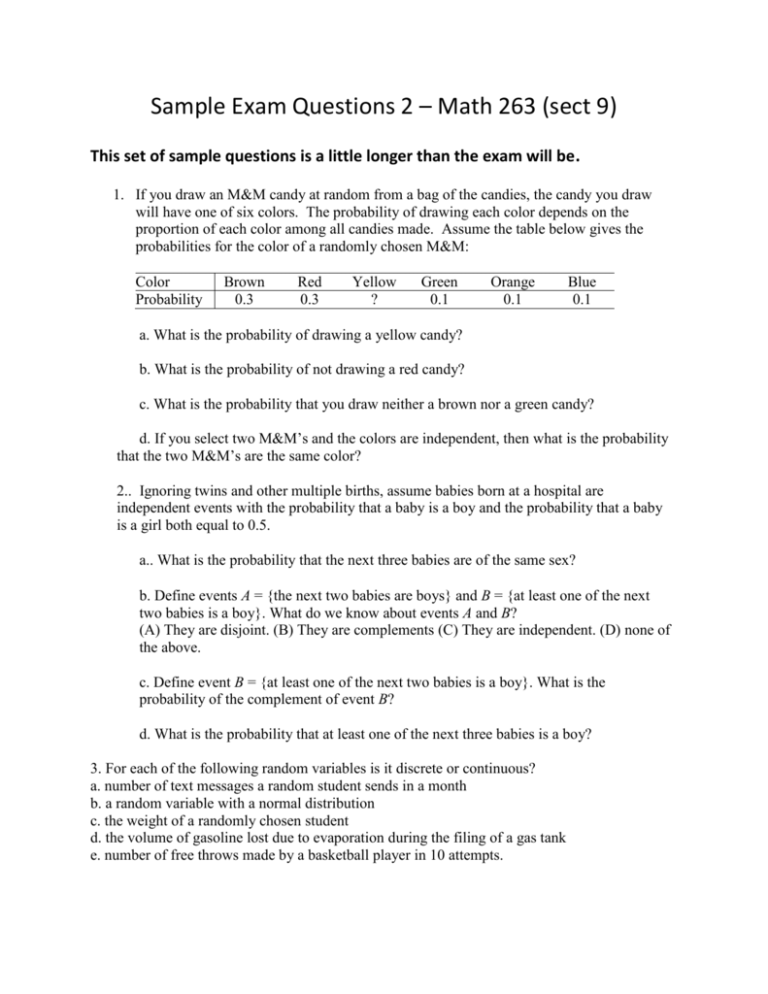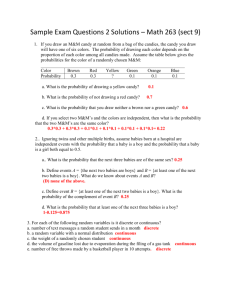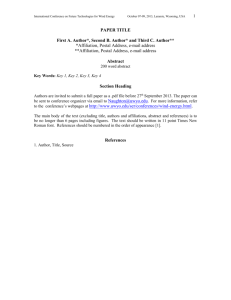This set of sample questions is a little longer than the exam will be
advertisement

Sample Exam Questions 2 – Math 263 (sect 9)
This set of sample questions is a little longer than the exam will be.
1. If you draw an M&M candy at random from a bag of the candies, the candy you draw
will have one of six colors. The probability of drawing each color depends on the
proportion of each color among all candies made. Assume the table below gives the
probabilities for the color of a randomly chosen M&M:
Color
Probability
Brown
0.3
Red
0.3
Yellow
?
Green
0.1
Orange
0.1
Blue
0.1
a. What is the probability of drawing a yellow candy?
b. What is the probability of not drawing a red candy?
c. What is the probability that you draw neither a brown nor a green candy?
d. If you select two M&M’s and the colors are independent, then what is the probability
that the two M&M’s are the same color?
2.. Ignoring twins and other multiple births, assume babies born at a hospital are
independent events with the probability that a baby is a boy and the probability that a baby
is a girl both equal to 0.5.
a.. What
is the probability that the next three babies are of the same sex?
b. Define events A = {the next two babies are boys} and B = {at least one of the next
two babies is a boy}. What do we know about events A and B?
(A) They are disjoint. (B) They are complements (C) They are independent. (D) none of
the above.
c. Define event B = {at least one of the next two babies is a boy}. What is the
probability of the complement of event B?
d. What is the probability that at least one of the next three babies is a boy?
3. For each of the following random variables is it discrete or continuous?
a. number of text messages a random student sends in a month
b. a random variable with a normal distribution
c. the weight of a randomly chosen student
d. the volume of gasoline lost due to evaporation during the filing of a gas tank
e. number of free throws made by a basketball player in 10 attempts.
4.. Suppose X is a continuous random variable taking values between 0 and 2 and having the
probability density function below:
1
0
0
1
2 X
a. What is P(1 ≤ X≤ 2)?
b.
What is P(X>1.5|X>1) ?
5..The American Veterinary Association claims that the annual cost of medical care for dogs averages
$100 with a standard deviation of $30. The cost for cats averages $120 with a standard deviation of $35.
Let X be the cost of a randomly chosen dog’s medical care minus the cost of a randomly chosen cat’s
medical care.
a. Find the mean and standard deviation of X
b. If the difference in costs follows a Normal distribution, what is the probability that the cost for
someone’s dog is higher than for the cat?
6..
The following table describes the probability distribution for the random variable X that counts
the number of times a customer visits a grocery store in a 1-week period:
Visits
P(Visits)
0
0.1
1
0.25
2
0.3
3
p
4
0.1
a. What is the value of p ?
b. Find the mean of X.
c. Find the standard deviation of X.
7. Among U of A freshmen, 40% are taking one or more math courses, 30% are taking one or
more English courses and 40% are taking one or more arts courses. 8% are taking one or more
math courses and one or more arts courses. 8% are taking one or more English courses and one
or more arts courses. There are no students taking courses in all three of the areas of math,
English and arts.
a. If we pick a freshman at random what is the probability he or she is not taking any course in
the areas of math, English or arts?
b. Are the events taking one or more math courses and taking one or more English courses
independent? Explain your answer.
c. Are the events taking one or more arts courses and taking one or more English courses
independent? Explain your answer.
8. The weight of medium-size tomatoes selected at random from a bin at the local supermarket is
a random variable with mean = 10 oz and standard deviation = 1 oz. Suppose we pick four
tomatoes from the bin at random and put them in a bag. Define the random variable Y to be the
weight of the bag containing the four tomatoes.
a. What is the mean of Y?
b. What is the standard deviation of Y?
9. 22% of the population of Arizona is over 60 years old. Among the people over 60, 45 % are
retired. Among the people 60 and younger only 8% are retired.
a. If I pick an Arizona resident at random what is the probability he or she is retired?
b. I pick an Arizona resident at random and find out he or she is retired. What is the
probability he or she is over 60?
10. When figure skaters need to find a partner for “pair figure skating,” it is important to find a
partner who is compatible in weight. The weight of figure skaters can be modeled by a Normal
distribution. For male skaters, the mean is 170 lbs with a standard deviation of 10 lbs. For female
skaters, the mean is 110 lbs with a standard deviation of 5 lbs. Let the random variable
X = the weight of female skaters and the random variable Y = the weight of male skaters.
a.
The weight of a pair of figure skaters (a male and a female) can be thought of as a new random
variable. Let the random variable W = X + Y. What is the mean of this new random variable W?
b.
Suppose we consider the weights of the male partner and the female partner to be independent.
What is the standard deviation of the random variable W?
c. It does seem likely that the weights of the male and the female partner would be
independent. If the correlation between X and Y equals 0.77, what is the standard deviation
of the random variable W
11.
A)
B)
C)
D)
12.
A)
B)
C)
D)
13.
A)
B)
C)
D)
In order to determine if smoking causes cancer, researchers surveyed a large sample of
adults. For each adult they recorded whether the person had smoked regularly at any
period in their life and whether the person had cancer. They then compared the
proportion of cancer cases in those who had smoked regularly at some time in their lives
with the proportion of cases in those who had never smoked regularly at any point in
their lives. The researchers found a higher proportion of cancer cases among those who
had smoked regularly than among those who had never smoked regularly. What type of
study is this?
An observational study.
An experiment, but not a double-blind experiment.
A double-blind experiment.
A block design.
Many studies are trying to find a cure for chronic back pain. In one such study, a
physician is comparing the medication currently being used (drug A) to a newly
developed drug (drug B). Seventy-three volunteers, suffering from chronic back pain,
are participating in this study. The physician’s assistant has a list of all 73 subjects and
randomly divides the subjects into two groups. Group 1 will receive drug A and Group 2
will receive drug B. The assistant is the only one who knows to which group the
subjects have been assigned. The physician monitors the subjects over a 2-month period
and the amount of improvement is recorded. What type of study is this?
An observational study.
An experiment, but not a double-blind experiment.
A double-blind experiment.
A matched-pairs experiment.
Bob has a severe cold. His roommate takes a garlic tablet every morning and has not
had a cold in two years. Bob’s aunt also has a friend who takes garlic tablets daily and
has not had a cold in more than a year. Based on these data, Bob decides to start taking
garlic tablets as soon as his cold clears up. What type of study is Bob’s decision based
on?
Anecdotal evidence.
An observational study based on available data.
An observational study based on a sample survey.
An experiment.
14.
A)
B)
C)
D)
15.
A)
B)
C)
D)
16.
A)
B)
C)
D)
In order to assess the effects of exercise on reducing cholesterol, a researcher sampled
50 people from a local gym who exercise regularly and 50 people from the surrounding
community who, were assumed, do not exercise regularly. Each subject reported to a
clinic to have their cholesterol measured. The subjects were unaware of the purpose of
the study, and the technician measuring the cholesterol was not aware of whether the
subject exercises regularly or not. What type of study is this?
An observational study.
An experiment, but not a double-blind experiment.
A double-blind experiment.
A matched-pairs experiment.
A study is designed to determine whether grades in a statistics course could be improved
by offering special review material. The 250 students enrolled in a large introductory
statistics class are also enrolled in one of 20 lab sections. The 20 lab sections are
randomly divided into 2 groups of 10 lab sections each. The students in the first set of
10 lab sections are given extra review material during the last 15 minutes of each
weekly lab session. The students in the remaining 10 lab sections receive the regular
lesson material, without the extra review material. The grades of the students who
reviewed weekly were higher, on average, than the students who did not review every
week. What type of study is this?
An observational study.
An experiment, but not a double-blind experiment.
A double-blind experiment.
A matched-pairs experiment.
A market research company wishes to find out which of two Internet search engines the
population of students at a university prefers to use: Google or MSN Search. A random
sample of students is selected, and each one is asked to search for a certain subject using
Google and then MSN, or vice versa. The order of the two searches was determined at
random. They then indicate which Internet search engine they prefer. What type of
study is this?
An observational study.
An experiment, but not a double-blind experiment.
A double-blind experiment.
None of the above.
17. One hundred volunteers who suffer from severe depression are available for a study. Fifty
are selected at random and are given a new drug that is thought to be particularly effective in
treating severe depression. The other 50 are given an existing drug for treating severe
depression. A psychiatrist evaluates the symptoms of all volunteers after four weeks in order to
determine if there has been substantial improvement in the severity of the depression.
a.
A)
B)
C)
D)
What is the explanatory variable or factor in this study?
Which drug the volunteers receive.
The use of randomization and the fact that this was a comparative study.
The extent to which the depression was reduced.
The use of a psychiatrist to evaluate the severity of depression.
b.
A)
B)
In which situation would this study be double-blind?
Neither drug had any identifying marks on it.
All volunteers were not allowed to see the psychiatrist nor was the psychiatrist allowed
to see the volunteers during the session when the psychiatrist evaluated the severity of
the depression.
Neither the volunteers nor the psychiatrist knew which treatment any person had
received.
All of the above.
C)
D)
18.
A)
B)
C)
D)
Suppose volunteers were first divided by gender, and then half of the men were
randomly assigned to the new drug and half of the women were assigned to the new
drug. The remaining volunteers received the other drug. What is this an example of?
Replication.
Confounding. The effects of gender will be mixed up with the effects of the drugs.
A block design.
A matched-pairs design.
19. Olivia is planning to take a foreign language class. To research how satisfied other students
are with their foreign language classes, she decides to take a sample of 20 such students. The
university offers classes in four languages: Spanish, German, French, and Japanese. She will
select a simple random sample of five students from each language. What sampling technique is
using ?
A)
B)
A simple random sample.
A stratified sample.
C)
D)
A multistage sample.
None of the above.
20. A marketing research firm wishes to determine if the adult men in Laramie, Wyoming, would
be interested in a new upscale men’s clothing store. From a list of all residential addresses in
Laramie, the firm selects a simple random sample of 100 and mails a brief questionnaire to each.
a.
A)
B)
C)
D)
What is the population of interest?
All adult men in Laramie, Wyoming.
All residential addresses in Laramie, Wyoming.
The members of the marketing firm that actually conducted the survey.
The 100 addresses to which the survey was mailed.
b.
A)
B)
C)
D)
What is the sample in this survey?
All adult men in Laramie, Wyoming.
All residential addresses in Laramie, Wyoming.
The members of the marketing firm that actually conducted the survey.
The 100 addresses to which the survey was mailed.







